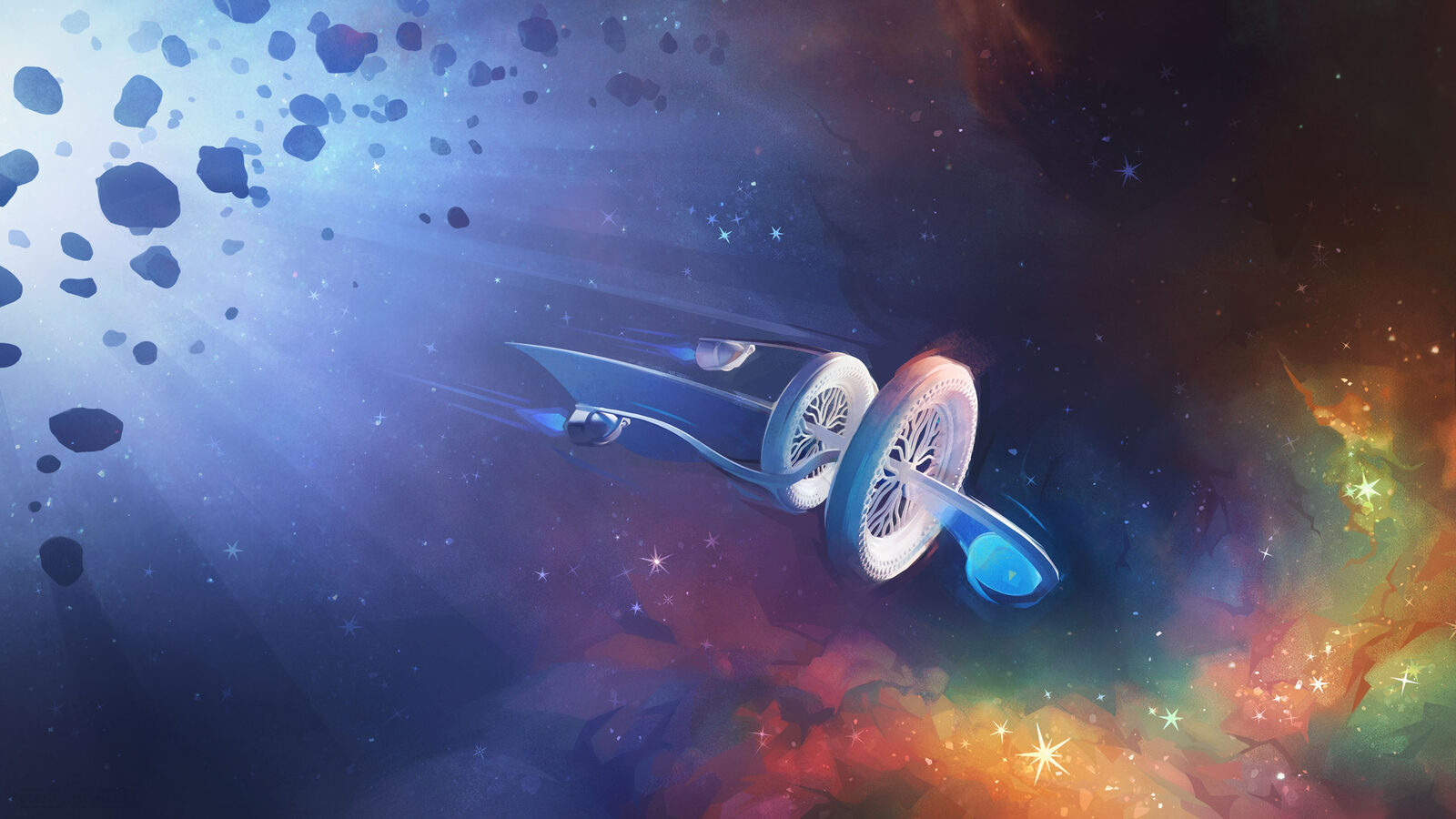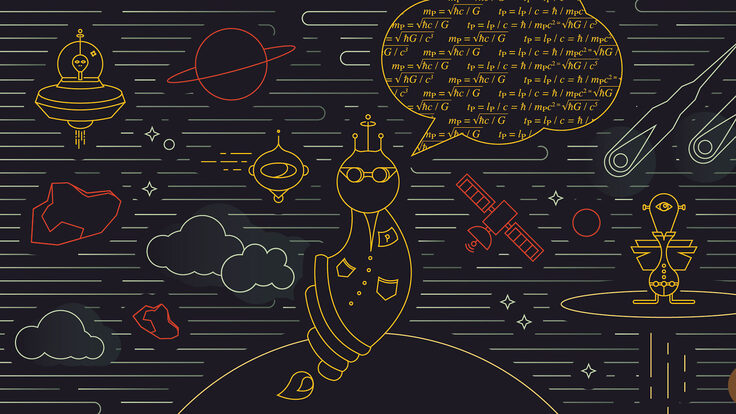In the beginning, a spaceship called the Yggdrasil is sailing through the cosmos to find a new home for its long-term inhabitants. Suddenly, the ship is hit by a stray asteroid, damaging the hydrogen fuel supply. The people aboard the Yggdrasil must use their knowledge of astrophysics to search for and retrieve a new supply of hydrogen.
This is the story students enter in “The Salvation of the Yggdrasil: An Immersive Astronomy Experience,” a new class developed by Sean Lindsay, a senior lecturer in astronomy at the University of Tennessee. Lindsay, who is the current Astronomy Coordinator at UT and who teaches the department’s introductory astronomy classes, has spent the last two years developing an immersive and imaginative astrophysics class based on an original science-fiction narrative.
“The intergenerational spaceship is a place where we can hit reset and reimagine what we think society should look like.”
Something about the idea of a generation ship—a ship designed to support multiple generations of travelers as it undertakes a journey that lasts longer than a human lifetime—has always called to Lindsay. “I’ve always been fascinated by origin stories, what I would call deep cultural myths that exist amongst humanity,” says Lindsay. “The intergenerational spaceship is a place where we can hit reset and reimagine what we think society should look like.”
The idea of re-invention and innovation runs deeply through Lindsay’s project. He wants to change the way science is taught.
Along with undergraduate physics student Adam Tilley, Lindsay has developed a science-fictional story arc for the class to follow. Tilley wrote a series of vignettes to accompany the curriculum and set the stage and characters for the class.
“I need you to search our most recent survey data to find a suitable star for hydrogen collection,” says Captain Liu, one of the characters in Tilley’s first story, chronicling the initial catastrophe and setting the ship’s crew into action. “And to everyone, I need you to hold your head high to ensure the salvation of the Yggdrasil. Our story doesn’t end here.”
Lindsay’s class is broken into three separate chapters, in which the students must accomplish different sub-goals to keep the starship moving on their mission to replace the lost hydrogen fuel.
In the first chapter, the students learn about stellar properties, and they then must identify a star that they can reach in the 30 years before their fuel runs out. In the second chapter, the students arrive at their chosen star and must figure out how much fuel they need to collect to complete their journey. And finally, in the last chapter, the Yggdrasil becomes lost in a molecular cloud, and the students have to find their way out so they can continue their migration.
Lindsay and Tilley made sure each part of the story was supported with science. “One of the most challenging aspects of developing this class was figuring out how to weave together an engaging story, accurate physics and educational material,” says Lindsay.
Chapter 3 was particularly challenging, says Tilley. “I remember spit-balling lots of various ideas before we had the molecular cloud idea. We spent maybe eight hours or something, drawing everything out on the whiteboard.”
Lindsay says it was worth the extra effort to try to hit the right balance of engaging and educational. “Learning happens best when you create opportunities for students to be self-motivated,” says Lindsay. “A lot of what I have done with designing this class is implementing new teaching philosophies that will really bolster intrinsic motivation.”
There are three psychological needs that must be satisfied for self-motivated learning to occur, says Lindsay. First, students need to have autonomy, the ability to make choices and do work that aligns with their interests. Second, students need to be able to relate to the material. That’s the purpose of presenting all the homework problems in the context of a science-fictional world, says Lindsay. “The students get to see how the material applies outside of the classroom.”
Lastly, for self-motivated learning to occur, students need to feel confident in their work and feel capable of working at the required level. Lindsay’s creative curriculum aims to meet each of these needs and provide students with a safe environment to learn and make mistakes. “I’m a strong advocate of learning from your mistakes, that’s how humans naturally learn,” says Lindsay. “I want to create a space where my students can actually learn from their mistakes.”
To achieve this, Lindsay applies an unconventional grading system. Instead of taking exams, the students submit reports with solutions to the dilemmas the crew of the Yggdrasil faces when they’ve completed each chapter of the class. Lindsay then gives them the go-ahead to continue to the next chapter, or he points out where they made their mistakes. “If I give you a thumbs down, it isn’t like you failed; I’m not going to assign you a grade. I’ll just look at your work and give you a gentle nudge in the right direction.”
In the first full-semester version of the class that Lindsay is teaching this spring, he will also try out alternative assessment strategies. Through written solution reports, project portfolios, and reflection, the students will evaluate the quality and progress of their own learning. They will have to assign themselves a letter grade and justify to Lindsay why they have earned that grade in both a written report and an oral defense.
“There are a lot of educators that have adopted this sort of self-assignment system, and the most common thing they must do is adjust the grades up, not down. Most students’ harshest critics are themselves,” says Lindsay.
For assessing the success of the class itself, Lindsay has a different set of criteria. He will be conducting IRB-approved education research with this class, using pre- and post-course surveys. Secretly though, he says, “a more realistic gauge is just if the students are enjoying the class.”
According to those who took a month-long pilot version of his new class, Lindsay seems to have succeeded on this point. Raghav Chari, one of Lindsay’s former students, says, “His class is one where I felt really motivated to come to class, and I actually enjoyed what we were doing. I wasn’t worried about making a certain grade. I learned the most in this class and wasn’t stressed about it, which is the ideal learning environment.”
Lindsay has even bigger aspirations. “This class I’ll be teaching in the spring is only a tiny subset of what my dream class would be,” says Lindsay. “I eventually want to create a curriculum that is highly interdisciplinary and taught by several instructors. We could have an astrophysicist, an engineer, and maybe things like sociology and botany. You’d get to see how everything interacts and see that no single academic discipline is in isolation.”
The focus of the class wouldn’t have to stay in the sciences, either, he says. “We could invite more creative writers to build the science fiction world and create new storylines. We could teach journalism by having students write newspaper articles for this society.”
The success of the class depends on a large community effort, Lindsay and Tilley both say. “We can’t stress enough that the full vision for this is a very large community-style project,” says Tilley.
Lindsay hopes that his students will help expand the world he has built, contributing further stories and bringing the spirit of the class beyond the classroom. “I want this class to be one that endures,” says Lindsay. “I want students to look back in ten, twenty years and remember, ‘That was a really fun, cool, and educational experience.’”







